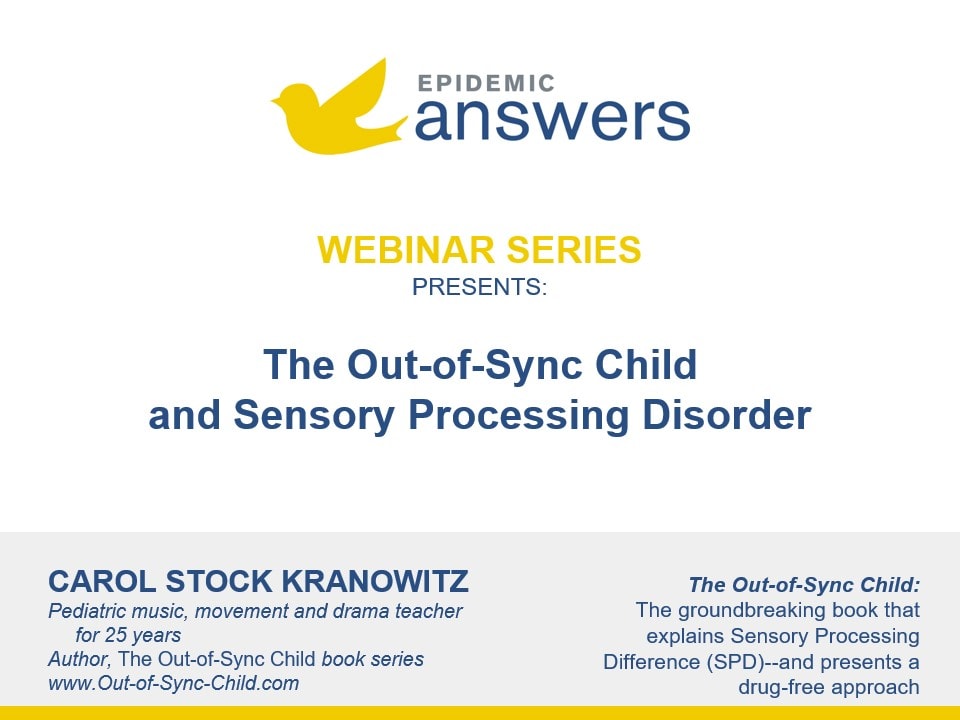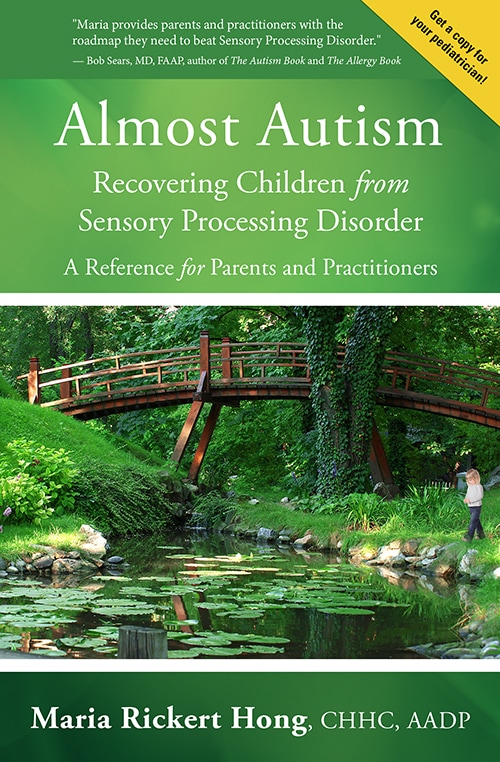What Is Sensory Processing Disorder?
Children with sensory processing disorder issues have great difficulty processing and acting upon information received through their senses. Have you ever seen a child who appears to be “out of sync” with how they interact with their environment? It may be that somehow the sensory signals in the brain are not available or they just don’t get organized enough to respond appropriately.
The result is children develop sensory-seeking or sensory-avoiding patterns because their nervous systems do not process the sensory input coming into the brain correctly. Consequently, they manifest over-sensitivity (hyper) and/or under-sensitivity (hypo) reactions or both.
There are eight senses involved in a child’s development which are necessary for processing information:
- Hearing or auditory processing which is connected to language and communication
- Touch or somatosensory or tactile which is touching the skin
- Taste (gustatory)
- Smell (olfactory) having difficulty with food textures and are picky eaters
- Vision, which is how the brain interprets visual input and supports hand/eye coordination
- Vestibular, which is the system that gives a sense of balance and spatial orientation
- Proprioception, which is the muscle and joint movement and sense of self
- Interoception, which is the understanding by the self to feel what is going on inside the body
On a daily basis, sensory processing can create many significant challenges, behaviors and disruptions for these children.
What Your Doctor May Tell You About Sensory Processing Disorder
Your child’s pediatrician may suggest sensory-based therapies such as occupational therapy with sensory integration (SI) as part of a comprehensive treatment plan for your child. However, your pediatrician may inform you that the amount of research regarding the effectiveness of SI therapy is limited and inconclusive.
He or she may also discuss the limitations of the treatment, suggest a doing a trial period of SI therapy, teach you how to evaluate the effectiveness of this therapy and discuss whether the therapy is actually working to achieve your child’s goals in the treatment plan.
It is not very clear to pediatricians whether children who present with sensory-based problems actually have a “disorder” of the sensory pathways of the brain or whether these deficits are characteristics of other developmental or behavioral disorders. In fact, your child’s pediatrician will probably make you aware that processing difficulties and issues with tolerating sensory information are characteristics also seen in:
- Autism spectrum disorders
- Attention deficit disorders
- Childhood anxiety disorders
- Developmental coordination disorders
Therefore, most likely your child’s pediatrician will request further testing as well as a thorough evaluation to be more conclusive.
Another Way to Think About Sensory Processing Disorder
When something as routine as a haircut, brushing your teeth, hearing the vacuum, a crowded store, drawing blood, or eating food is an excruciating experience for a child, it is more than likely because they are in pain trying to communicate that their body feels as though it is being attacked by their external environment.
A healthy microbiome is fundamental to all brain functioning and the gut/brain connection needs to be functioning in order to for sensory information to be processed appropriately.
In the brain are chemical messengers that transmit signals from one neuron to another telling the brain and body what to do. These messengers are called “neurotransmitters” (NT) and they are also located in our gastrointestinal tract which allows for communication with the brain. Amino acids, which come from protein, feed the NTs, and the NTs in turn tell the brain cells how to motor plan, process sensory information, have appropriate behavior, formulate normal muscle tone and so on.
Therefore, implementing ideas listed in our checklist below and removing all stressors may likely dramatically change over time how your child navigates their world. The good news is that recovery is possible from Sensory Processing Disorder by rebalancing the body and bringing it back to health.
Autism, ADD/ADHD and SPD Comorbidities
Knowledgeable practitioners have found that roughly 30-50% of children with autism, ADD/ADHD and Sensory Processing Disorder (SPD) also have PANS PANDAS. These are newer diagnoses that your child’s pediatrician or psychiatrist may not be aware of. They are disorders that are loosely defined as a sudden onset of acute anxiety and mood variability accompanied by OCD (Obsessive Compulsive Disorder) and/or tics.
PANDAS stands for Pediatric Autoimmune Neuropsychiatric Disorders Associated with Streptococcal Infections. With PANDAS, the onset of symptoms is typically preceded by streptococcal -A infection (“strep throat”). However, in some cases, children may not have presented with a full-blown, acute strep throat infection.
PANDAS is included in the larger umbrella of PANS, Pediatric Acute-onset Neuropsychiatric Syndrome. PANS includes not only PANDAS, but also diagnoses such as Lyme disease, OCD and ODD. In addition, it is very common for younger siblings of children diagnosed with autism, ADD/ADHD or Sensory Processing Disorder to be diagnosed themselves with PANS and PANDAS. If this is the case, consider that your older child may have PANS PANDAS as well. In many cases, these children have both a PANDAS diagnosis as well as that of Lyme disease.
Autoimmune Encephalitis
Another way to think of PANS PANDAS, as well as any neurodevelopmental disorder such as autism, ADD/ADHD, Sensory Processing Disorder and even learning disabilities, is that these disorders may fall under the larger umbrella of autoimmune encephalitis (AE). Autoimmune encephalitis is a disorder in which the immune system attacks the brain, impairing function.
Encephalitis is inflammation and swelling of the brain, often due to infection, which in many of these cases causes an autoimmune attack on the microglia cells of the brain. A child with this type of damage may typically never have or may lose motor skills and/or the ability to speak, similar to an adult who has had a stroke.
Encephalitis is a common symptom of this type of damage, and it often shows up as an increase in the child’s head-circumference percentile, especially in the first year of life.
The prestigious science journal Nature pointed this out by stating that “brain volume overgrowth was linked to the emergence and severity of autistic social deficits.”
Anti-NDMA Receptor Encephalitis
The N-methyl-D-aspartate receptor (also known as the NMDA receptor), is a glutamate receptor found in nerve cells. It is activated when the amino acids glutamate and glycine bind to it.
NMDA receptors have been implicated by a number of studies to be strongly involved with excitotoxicity, the process by which nerve cells are damaged or killed by excessive stimulation by neurotransmitters such as glutamate. Excitoxicity can cause encephalopathy and seizures.
Glutamate and its analogs are found in processed foods not only as MSG (monosodium glutatmate), but also in chemical food additives such as:
- Hydrolyzed vegetable protein
- Soy protein isolate
- Yeast extract
- Gelatin
- Barley malt
- Bouillon
- Natural flavoring
- Artificial flavoring
- Soy sauce
Even natural foods such as tomatoes, bone broth and seaweed may naturally have high levels of glutamate. Strep also increases glutamate in the brain.
Sensory Processing Disorder Healing Checklist
Still Looking for Answers?
Visit the Epidemic Answers Practitioner Directory to find a practitioner near you.
Join us inside our online membership community for parents, Healing Together, where you’ll find even more healing resources, expert guidance, and a community to support you every step of your child’s healing journey.
Sources & References
Aguilera, M., et al. Antibiotic-induced dysbiosis alters host-bacterial interactions and leads to colonic sensory and motor changes in mice. Gut Microbes. 2015;6(1):10-23.
Ahn, R.R., et al. Prevalence of parents’ perceptions of sensory processing disorders among kindergarten children. Am J Occup Ther. May-Jun 2004;58(3):287-93.
Ben-Sasson, A., et al. Sensory over-responsivity in elementary school: prevalence and social-emotional correlates. J Abnorm Child Psychol. 2009 Jul;37(5):705-16.
Boat, T.F., et al. Prevalence of Learning Disabilities. Mental Disorders and Disabilities Among Low-Income Children. Washington (DC): National Academies Press (US); 2015 Oct 28. 16.
Borre, Y.E., et al. Microbiota and neurodevelopmental windows: implications for brain disorders. Trends Mol Med. 2014 Sep;20(9):509-18.
Darling, A.L., et al. Association between maternal vitamin D status in pregnancy and neurodevelopmental outcomes in childhood: results from the Avon Longitudinal Study of Parents and Children (ALSPAC). Br J Nutr. 2017 Jun;117(12):1682-1692.
Egset, K., et al. Magno App: Exploring Visual Processing in Adults with High and Low Reading Competence. Scandinavian Journal of Educational Research. 07 Jan 2020.
Hertz-Picciotto, I., et al. Organophosphate exposures during pregnancy and child neurodevelopment: Recommendations for essential policy reforms. PLoS Med. 2018 Oct 24;15(10):e1002671.
Maenner, M.J., et al. Prevalence and Characteristics of Autism Spectrum Disorder Among Children Aged 8 Years – Autism and Developmental Disabilities Monitoring Network, 11 Sites, United States, 2018. MMWR Surveill Summ. 2021 Dec 3;70(11):1-16.
Morris, C.R., et al. Syndrome of allergy, apraxia, and malabsorption: characterization of a neurodevelopmental phenotype that responds to omega 3 and vitamin E supplementation. Alternative Therapies in Health and Medicine. Jul-Aug 2009;15(4):34-43.
Piek, J.P., et al. Sensory-motor deficits in children with developmental coordination disorder, attention deficit hyperactivity disorder and autistic disorder. Hum Mov Sci. 2004 Oct;23(3-4):475-88.
Assessment of Sensory Processing and Executive Functions at the School: Development, Reliability, and Validity of EPYFEI-Escolar. Front Pediatr. 2020 May 29;8:275.
Tomcheck, S.D., et al. Sensory Processing in Children with and without Autism: A Comparative Study Using the Short Sensory Profile. American Journal of Occupational Therapy. 2007. 61, 190-200.
Warner, B.B. The contribution of the gut microbiome to neurodevelopment and neuropsychiatric disorders. Pediatr Res. 2019 Jan;85(2):216-224.
Zablotsky, B., et al. Prevalence and Trends of Developmental Disabilities among Children in the United States: 2009-2017. Pediatrics. 2019 Oct;144(4):e20190811.
Zaigham, M., et al. Prelabour caesarean section and neurodevelopmental outcome at 4 and 12 months of age: an observational study. BMC Pregnancy and Childbirth. 2020 (20)564.
Resources
Books
Biel, Lindsey. Raising a Sensory Smart Child: The Definitive Handbook for Helping Your Child with Sensory Processing Issues. Revised Edition, 2009
Hong, Maria Rickert. Almost Autism: Recovering Children from Sensory Processing Disorder, A Reference for Parents and Practitioners. 2014.
Kranowitz, Carol. The Out-of-Sync Child: Recognizing and Coping with Sensory Processing Disorder. Penguin Random House, revised edition 2022.
Lambert, Beth, et al. Brain Under Attack: A Resource for Parents and Caregivers of Children with PANS, PANDAS, and Autoimmune Encephalitis. Answers Publications, 2018.




